Emerging Themes: Diversity and Inclusion in Human Resource Management
VerifiedAdded on 2023/06/10
|15
|4327
|479
Report
AI Summary
This report delves into the critical understanding of emerging themes related to diversity and inclusion in the workplace. It analyzes the findings of a case study, highlighting the persistence of inequality despite efforts towards equality legislation. The report examines the outcomes of diversity, implications for HR professionals, and factors contributing to inequality, such as prejudice and recruitment bias. It also explores factors supporting inclusion, like diversity training, and discusses the future of diversity and inclusion, emphasizing the importance of leadership involvement and cultural change. Furthermore, the report assesses the influence of political, technological, demographic, social, and economic factors on diversity and inclusion, providing recommendations for fostering an inclusive environment. The report emphasizes the need for a holistic approach to diversity, considering societal, community, individual, and organizational development.
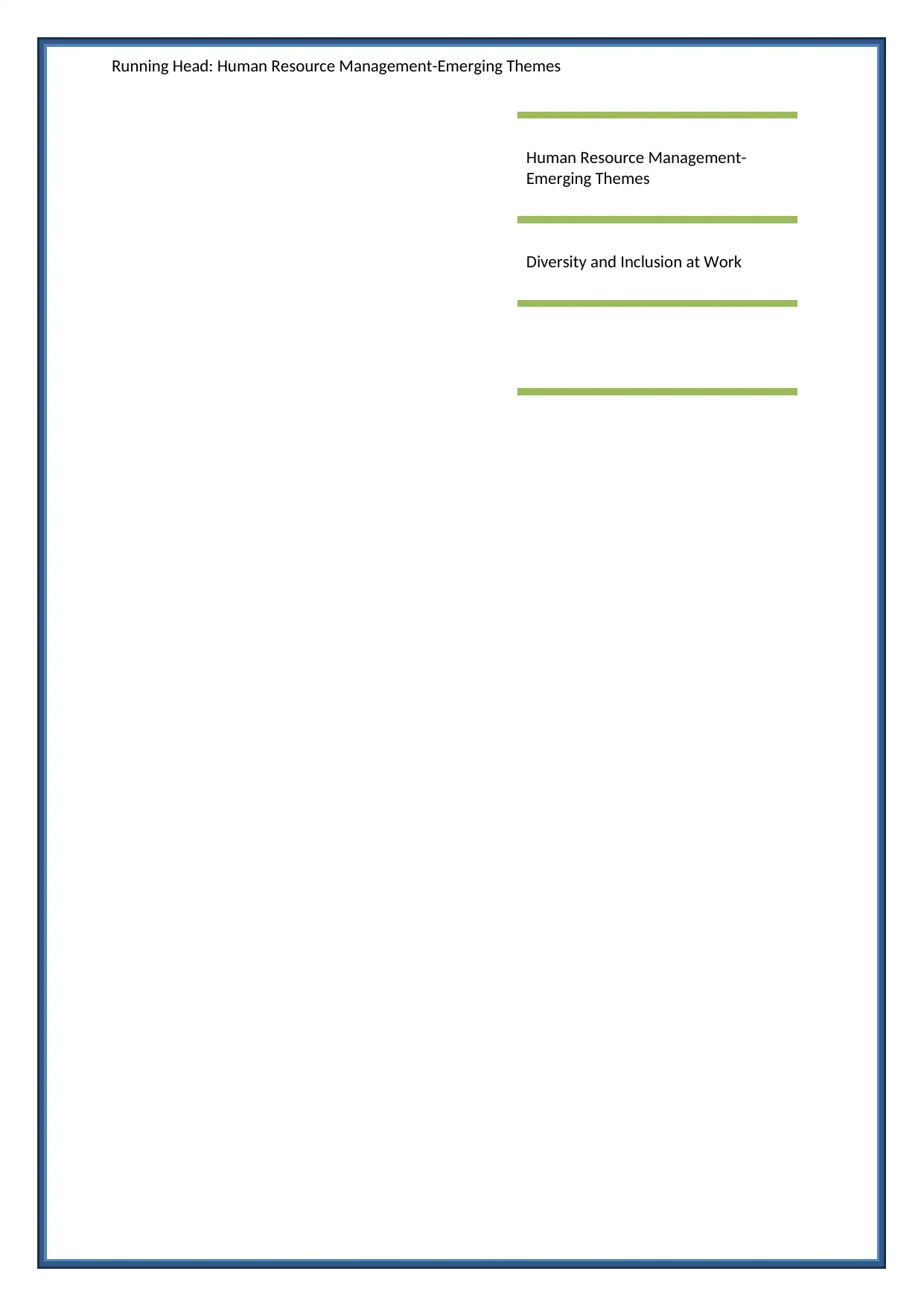
Running Head: Human Resource Management-Emerging Themes
Human Resource Management-
Emerging Themes
Diversity and Inclusion at Work
Human Resource Management-
Emerging Themes
Diversity and Inclusion at Work
Paraphrase This Document
Need a fresh take? Get an instant paraphrase of this document with our AI Paraphraser
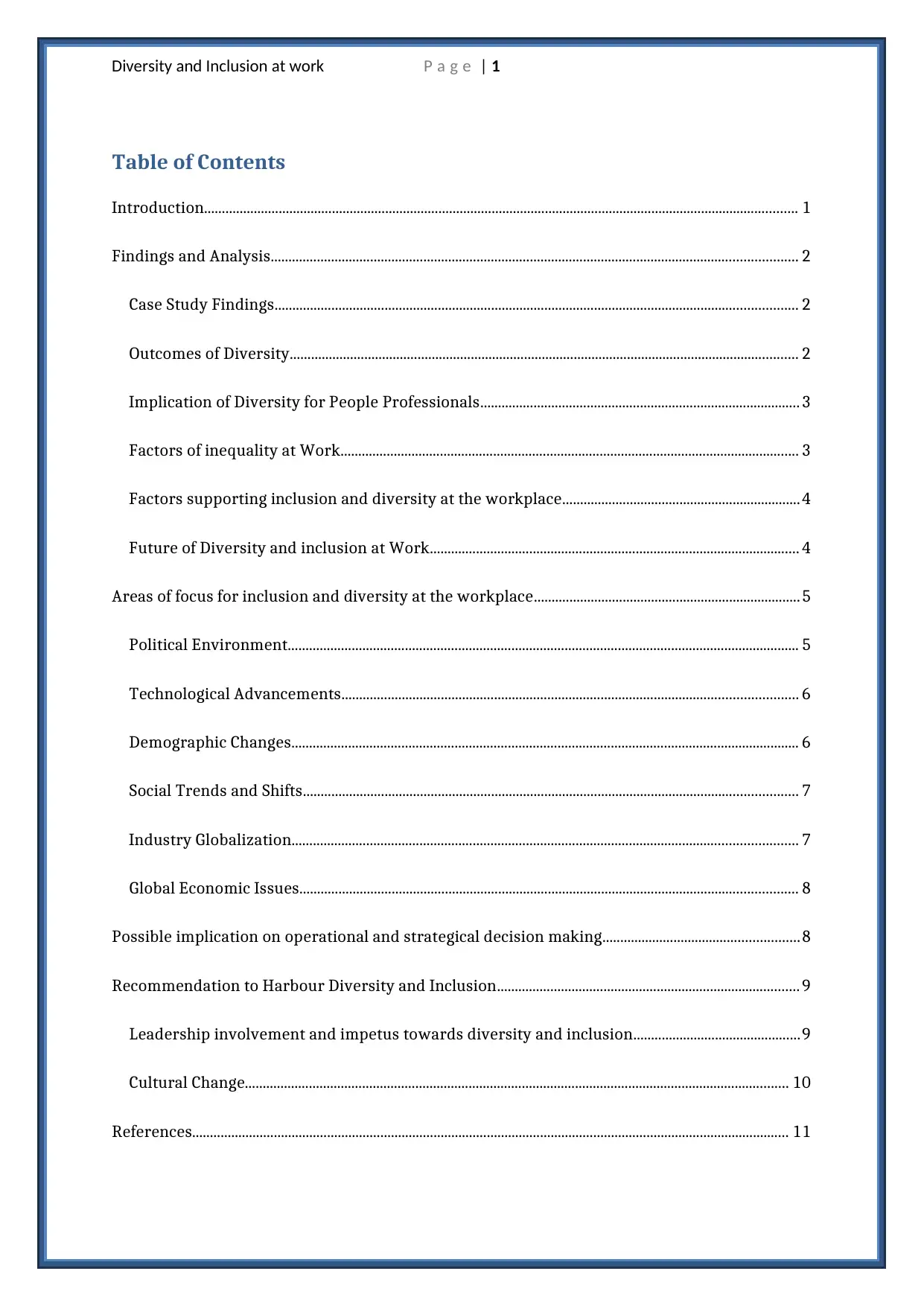
Diversity and Inclusion at work P a g e | 1
Table of Contents
Introduction....................................................................................................................................................................... 1
Findings and Analysis.................................................................................................................................................... 2
Case Study Findings................................................................................................................................................... 2
Outcomes of Diversity............................................................................................................................................... 2
Implication of Diversity for People Professionals..........................................................................................3
Factors of inequality at Work................................................................................................................................. 3
Factors supporting inclusion and diversity at the workplace...................................................................4
Future of Diversity and inclusion at Work........................................................................................................ 4
Areas of focus for inclusion and diversity at the workplace...........................................................................5
Political Environment................................................................................................................................................ 5
Technological Advancements................................................................................................................................ 6
Demographic Changes............................................................................................................................................... 6
Social Trends and Shifts........................................................................................................................................... 7
Industry Globalization.............................................................................................................................................. 7
Global Economic Issues............................................................................................................................................ 8
Possible implication on operational and strategical decision making.......................................................8
Recommendation to Harbour Diversity and Inclusion..................................................................................... 9
Leadership involvement and impetus towards diversity and inclusion...............................................9
Cultural Change......................................................................................................................................................... 10
References........................................................................................................................................................................ 11
Table of Contents
Introduction....................................................................................................................................................................... 1
Findings and Analysis.................................................................................................................................................... 2
Case Study Findings................................................................................................................................................... 2
Outcomes of Diversity............................................................................................................................................... 2
Implication of Diversity for People Professionals..........................................................................................3
Factors of inequality at Work................................................................................................................................. 3
Factors supporting inclusion and diversity at the workplace...................................................................4
Future of Diversity and inclusion at Work........................................................................................................ 4
Areas of focus for inclusion and diversity at the workplace...........................................................................5
Political Environment................................................................................................................................................ 5
Technological Advancements................................................................................................................................ 6
Demographic Changes............................................................................................................................................... 6
Social Trends and Shifts........................................................................................................................................... 7
Industry Globalization.............................................................................................................................................. 7
Global Economic Issues............................................................................................................................................ 8
Possible implication on operational and strategical decision making.......................................................8
Recommendation to Harbour Diversity and Inclusion..................................................................................... 9
Leadership involvement and impetus towards diversity and inclusion...............................................9
Cultural Change......................................................................................................................................................... 10
References........................................................................................................................................................................ 11
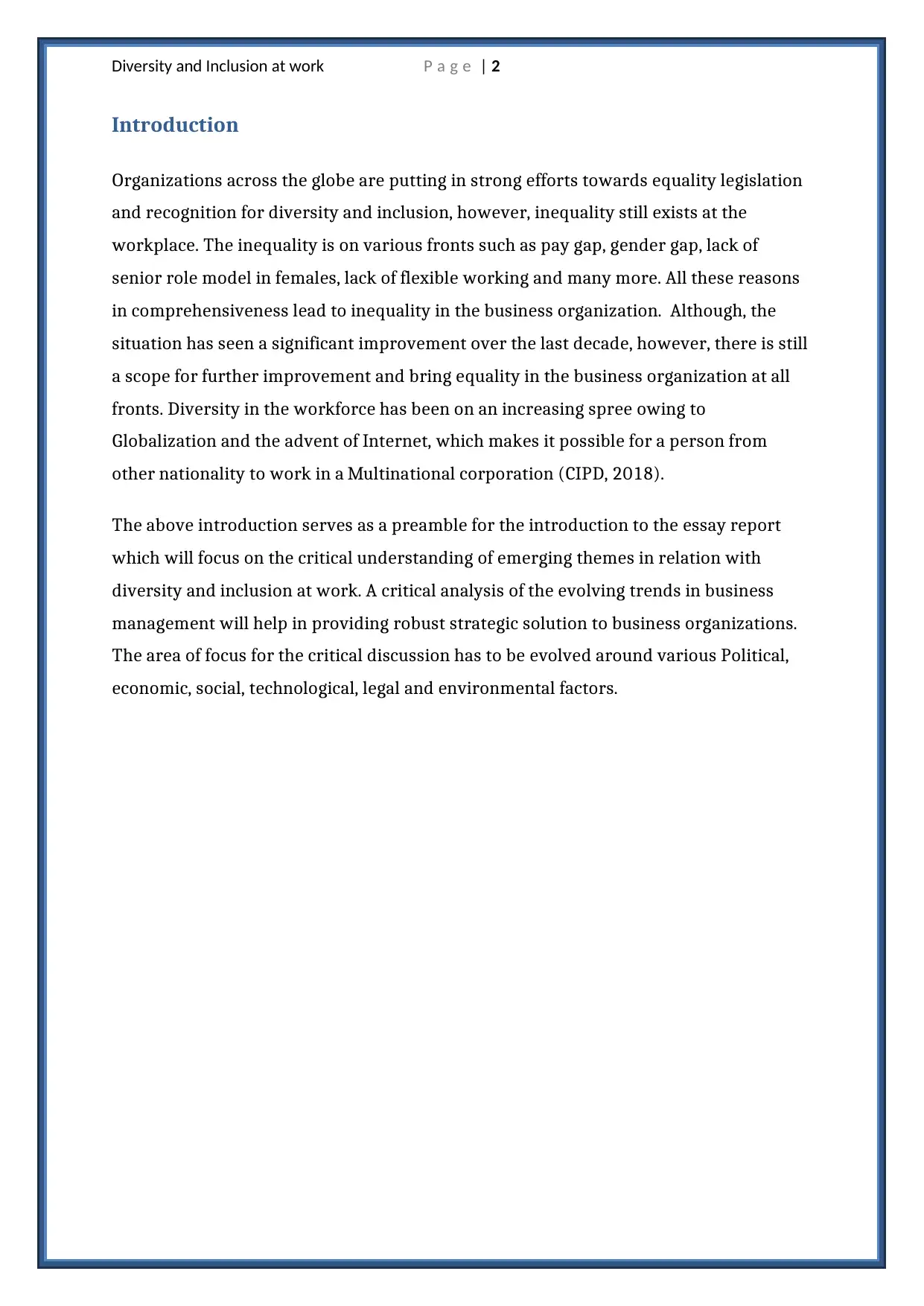
Diversity and Inclusion at work P a g e | 2
Introduction
Organizations across the globe are putting in strong efforts towards equality legislation
and recognition for diversity and inclusion, however, inequality still exists at the
workplace. The inequality is on various fronts such as pay gap, gender gap, lack of
senior role model in females, lack of flexible working and many more. All these reasons
in comprehensiveness lead to inequality in the business organization. Although, the
situation has seen a significant improvement over the last decade, however, there is still
a scope for further improvement and bring equality in the business organization at all
fronts. Diversity in the workforce has been on an increasing spree owing to
Globalization and the advent of Internet, which makes it possible for a person from
other nationality to work in a Multinational corporation (CIPD, 2018).
The above introduction serves as a preamble for the introduction to the essay report
which will focus on the critical understanding of emerging themes in relation with
diversity and inclusion at work. A critical analysis of the evolving trends in business
management will help in providing robust strategic solution to business organizations.
The area of focus for the critical discussion has to be evolved around various Political,
economic, social, technological, legal and environmental factors.
Introduction
Organizations across the globe are putting in strong efforts towards equality legislation
and recognition for diversity and inclusion, however, inequality still exists at the
workplace. The inequality is on various fronts such as pay gap, gender gap, lack of
senior role model in females, lack of flexible working and many more. All these reasons
in comprehensiveness lead to inequality in the business organization. Although, the
situation has seen a significant improvement over the last decade, however, there is still
a scope for further improvement and bring equality in the business organization at all
fronts. Diversity in the workforce has been on an increasing spree owing to
Globalization and the advent of Internet, which makes it possible for a person from
other nationality to work in a Multinational corporation (CIPD, 2018).
The above introduction serves as a preamble for the introduction to the essay report
which will focus on the critical understanding of emerging themes in relation with
diversity and inclusion at work. A critical analysis of the evolving trends in business
management will help in providing robust strategic solution to business organizations.
The area of focus for the critical discussion has to be evolved around various Political,
economic, social, technological, legal and environmental factors.
⊘ This is a preview!⊘
Do you want full access?
Subscribe today to unlock all pages.

Trusted by 1+ million students worldwide
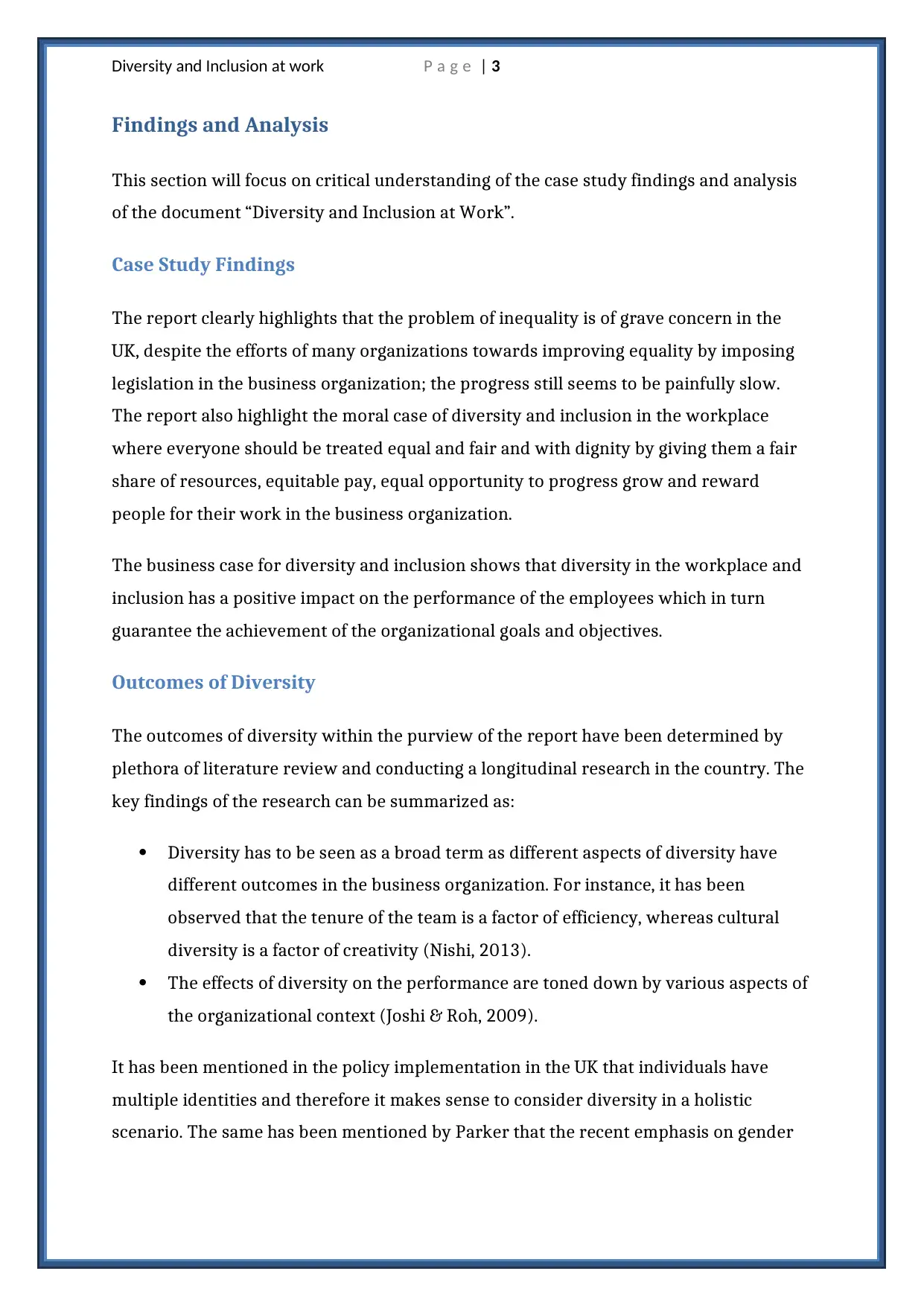
Diversity and Inclusion at work P a g e | 3
Findings and Analysis
This section will focus on critical understanding of the case study findings and analysis
of the document “Diversity and Inclusion at Work”.
Case Study Findings
The report clearly highlights that the problem of inequality is of grave concern in the
UK, despite the efforts of many organizations towards improving equality by imposing
legislation in the business organization; the progress still seems to be painfully slow.
The report also highlight the moral case of diversity and inclusion in the workplace
where everyone should be treated equal and fair and with dignity by giving them a fair
share of resources, equitable pay, equal opportunity to progress grow and reward
people for their work in the business organization.
The business case for diversity and inclusion shows that diversity in the workplace and
inclusion has a positive impact on the performance of the employees which in turn
guarantee the achievement of the organizational goals and objectives.
Outcomes of Diversity
The outcomes of diversity within the purview of the report have been determined by
plethora of literature review and conducting a longitudinal research in the country. The
key findings of the research can be summarized as:
Diversity has to be seen as a broad term as different aspects of diversity have
different outcomes in the business organization. For instance, it has been
observed that the tenure of the team is a factor of efficiency, whereas cultural
diversity is a factor of creativity (Nishi, 2013).
The effects of diversity on the performance are toned down by various aspects of
the organizational context (Joshi & Roh, 2009).
It has been mentioned in the policy implementation in the UK that individuals have
multiple identities and therefore it makes sense to consider diversity in a holistic
scenario. The same has been mentioned by Parker that the recent emphasis on gender
Findings and Analysis
This section will focus on critical understanding of the case study findings and analysis
of the document “Diversity and Inclusion at Work”.
Case Study Findings
The report clearly highlights that the problem of inequality is of grave concern in the
UK, despite the efforts of many organizations towards improving equality by imposing
legislation in the business organization; the progress still seems to be painfully slow.
The report also highlight the moral case of diversity and inclusion in the workplace
where everyone should be treated equal and fair and with dignity by giving them a fair
share of resources, equitable pay, equal opportunity to progress grow and reward
people for their work in the business organization.
The business case for diversity and inclusion shows that diversity in the workplace and
inclusion has a positive impact on the performance of the employees which in turn
guarantee the achievement of the organizational goals and objectives.
Outcomes of Diversity
The outcomes of diversity within the purview of the report have been determined by
plethora of literature review and conducting a longitudinal research in the country. The
key findings of the research can be summarized as:
Diversity has to be seen as a broad term as different aspects of diversity have
different outcomes in the business organization. For instance, it has been
observed that the tenure of the team is a factor of efficiency, whereas cultural
diversity is a factor of creativity (Nishi, 2013).
The effects of diversity on the performance are toned down by various aspects of
the organizational context (Joshi & Roh, 2009).
It has been mentioned in the policy implementation in the UK that individuals have
multiple identities and therefore it makes sense to consider diversity in a holistic
scenario. The same has been mentioned by Parker that the recent emphasis on gender
Paraphrase This Document
Need a fresh take? Get an instant paraphrase of this document with our AI Paraphraser
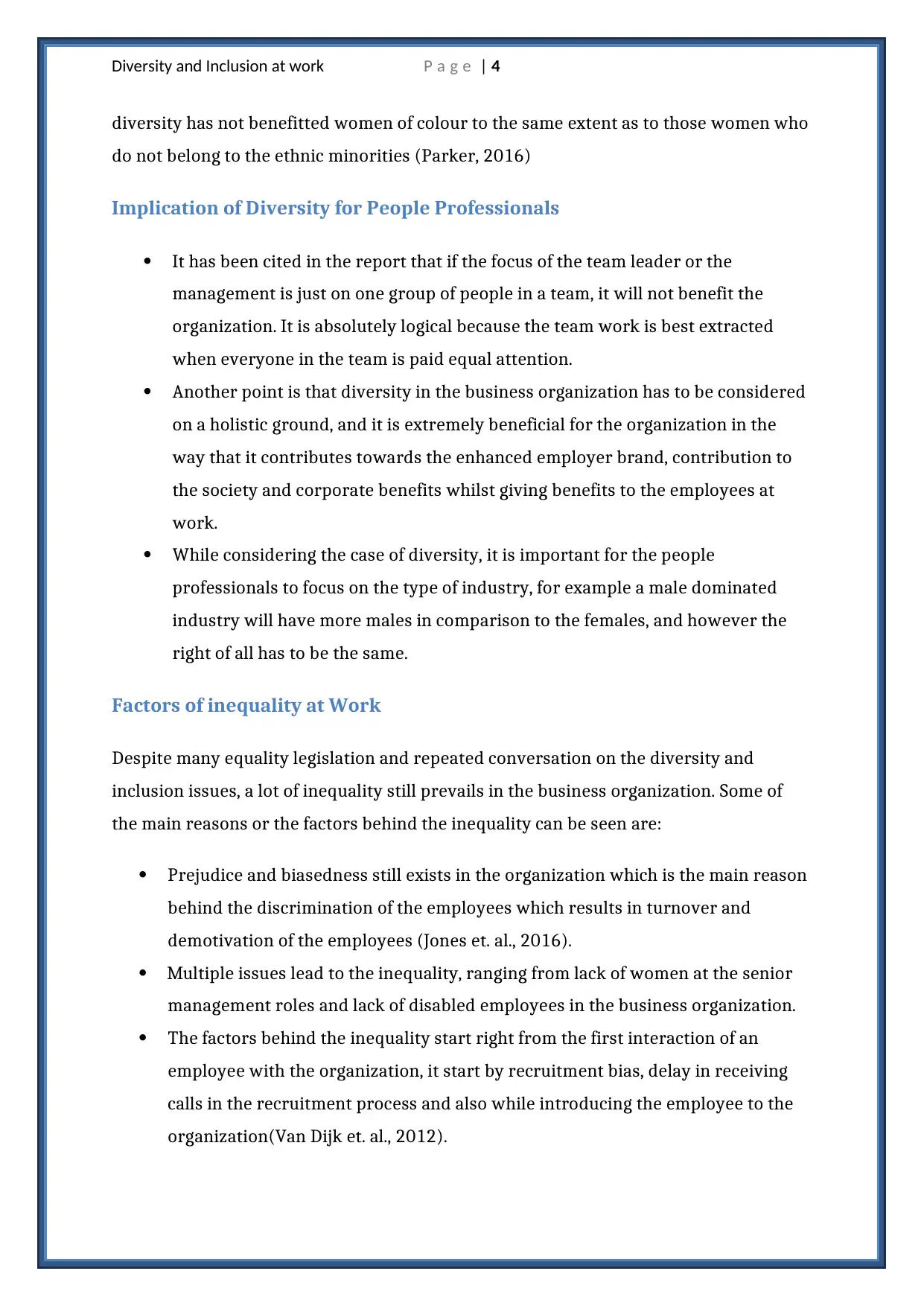
Diversity and Inclusion at work P a g e | 4
diversity has not benefitted women of colour to the same extent as to those women who
do not belong to the ethnic minorities (Parker, 2016)
Implication of Diversity for People Professionals
It has been cited in the report that if the focus of the team leader or the
management is just on one group of people in a team, it will not benefit the
organization. It is absolutely logical because the team work is best extracted
when everyone in the team is paid equal attention.
Another point is that diversity in the business organization has to be considered
on a holistic ground, and it is extremely beneficial for the organization in the
way that it contributes towards the enhanced employer brand, contribution to
the society and corporate benefits whilst giving benefits to the employees at
work.
While considering the case of diversity, it is important for the people
professionals to focus on the type of industry, for example a male dominated
industry will have more males in comparison to the females, and however the
right of all has to be the same.
Factors of inequality at Work
Despite many equality legislation and repeated conversation on the diversity and
inclusion issues, a lot of inequality still prevails in the business organization. Some of
the main reasons or the factors behind the inequality can be seen are:
Prejudice and biasedness still exists in the organization which is the main reason
behind the discrimination of the employees which results in turnover and
demotivation of the employees (Jones et. al., 2016).
Multiple issues lead to the inequality, ranging from lack of women at the senior
management roles and lack of disabled employees in the business organization.
The factors behind the inequality start right from the first interaction of an
employee with the organization, it start by recruitment bias, delay in receiving
calls in the recruitment process and also while introducing the employee to the
organization(Van Dijk et. al., 2012).
diversity has not benefitted women of colour to the same extent as to those women who
do not belong to the ethnic minorities (Parker, 2016)
Implication of Diversity for People Professionals
It has been cited in the report that if the focus of the team leader or the
management is just on one group of people in a team, it will not benefit the
organization. It is absolutely logical because the team work is best extracted
when everyone in the team is paid equal attention.
Another point is that diversity in the business organization has to be considered
on a holistic ground, and it is extremely beneficial for the organization in the
way that it contributes towards the enhanced employer brand, contribution to
the society and corporate benefits whilst giving benefits to the employees at
work.
While considering the case of diversity, it is important for the people
professionals to focus on the type of industry, for example a male dominated
industry will have more males in comparison to the females, and however the
right of all has to be the same.
Factors of inequality at Work
Despite many equality legislation and repeated conversation on the diversity and
inclusion issues, a lot of inequality still prevails in the business organization. Some of
the main reasons or the factors behind the inequality can be seen are:
Prejudice and biasedness still exists in the organization which is the main reason
behind the discrimination of the employees which results in turnover and
demotivation of the employees (Jones et. al., 2016).
Multiple issues lead to the inequality, ranging from lack of women at the senior
management roles and lack of disabled employees in the business organization.
The factors behind the inequality start right from the first interaction of an
employee with the organization, it start by recruitment bias, delay in receiving
calls in the recruitment process and also while introducing the employee to the
organization(Van Dijk et. al., 2012).
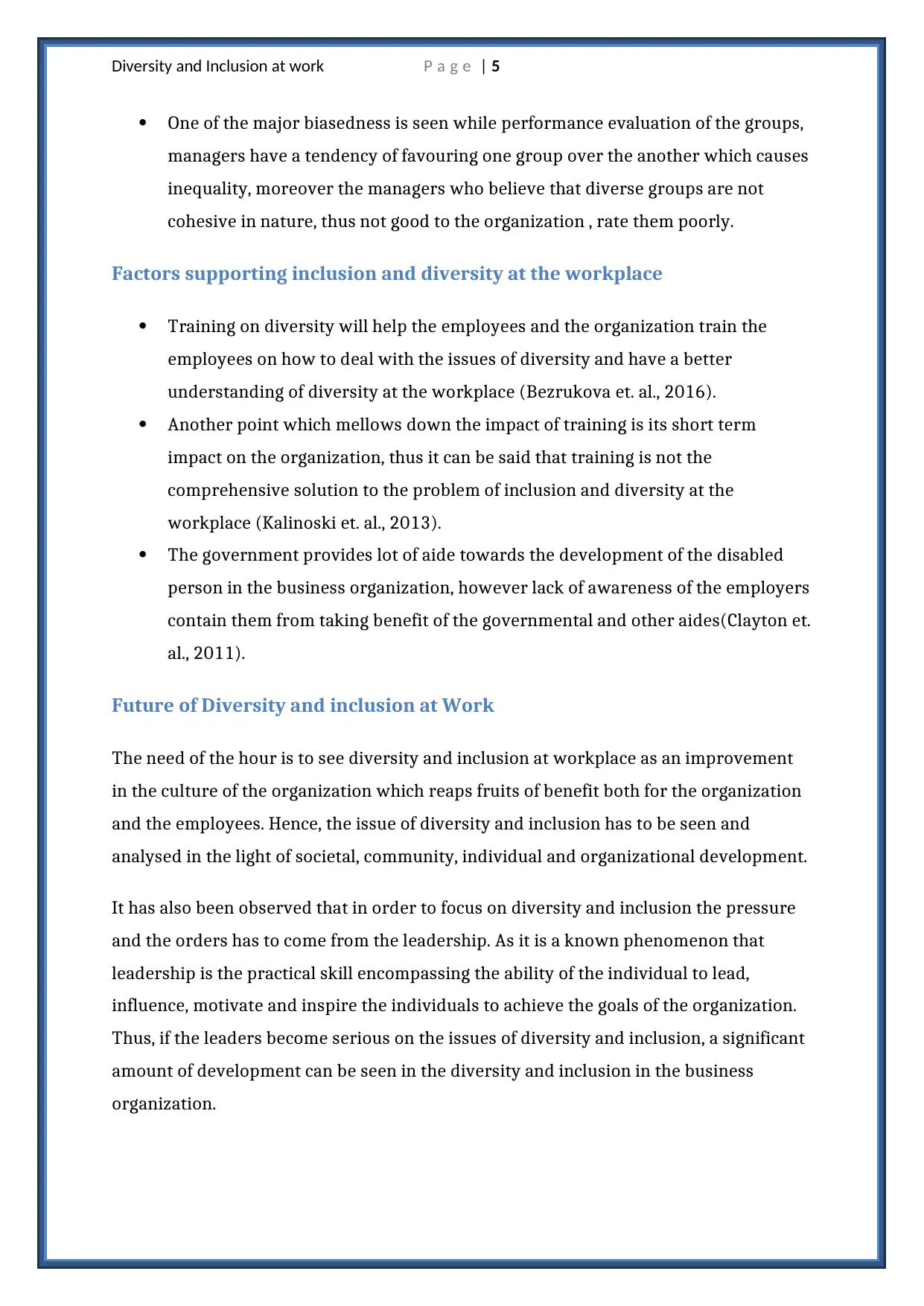
Diversity and Inclusion at work P a g e | 5
One of the major biasedness is seen while performance evaluation of the groups,
managers have a tendency of favouring one group over the another which causes
inequality, moreover the managers who believe that diverse groups are not
cohesive in nature, thus not good to the organization , rate them poorly.
Factors supporting inclusion and diversity at the workplace
Training on diversity will help the employees and the organization train the
employees on how to deal with the issues of diversity and have a better
understanding of diversity at the workplace (Bezrukova et. al., 2016).
Another point which mellows down the impact of training is its short term
impact on the organization, thus it can be said that training is not the
comprehensive solution to the problem of inclusion and diversity at the
workplace (Kalinoski et. al., 2013).
The government provides lot of aide towards the development of the disabled
person in the business organization, however lack of awareness of the employers
contain them from taking benefit of the governmental and other aides(Clayton et.
al., 2011).
Future of Diversity and inclusion at Work
The need of the hour is to see diversity and inclusion at workplace as an improvement
in the culture of the organization which reaps fruits of benefit both for the organization
and the employees. Hence, the issue of diversity and inclusion has to be seen and
analysed in the light of societal, community, individual and organizational development.
It has also been observed that in order to focus on diversity and inclusion the pressure
and the orders has to come from the leadership. As it is a known phenomenon that
leadership is the practical skill encompassing the ability of the individual to lead,
influence, motivate and inspire the individuals to achieve the goals of the organization.
Thus, if the leaders become serious on the issues of diversity and inclusion, a significant
amount of development can be seen in the diversity and inclusion in the business
organization.
One of the major biasedness is seen while performance evaluation of the groups,
managers have a tendency of favouring one group over the another which causes
inequality, moreover the managers who believe that diverse groups are not
cohesive in nature, thus not good to the organization , rate them poorly.
Factors supporting inclusion and diversity at the workplace
Training on diversity will help the employees and the organization train the
employees on how to deal with the issues of diversity and have a better
understanding of diversity at the workplace (Bezrukova et. al., 2016).
Another point which mellows down the impact of training is its short term
impact on the organization, thus it can be said that training is not the
comprehensive solution to the problem of inclusion and diversity at the
workplace (Kalinoski et. al., 2013).
The government provides lot of aide towards the development of the disabled
person in the business organization, however lack of awareness of the employers
contain them from taking benefit of the governmental and other aides(Clayton et.
al., 2011).
Future of Diversity and inclusion at Work
The need of the hour is to see diversity and inclusion at workplace as an improvement
in the culture of the organization which reaps fruits of benefit both for the organization
and the employees. Hence, the issue of diversity and inclusion has to be seen and
analysed in the light of societal, community, individual and organizational development.
It has also been observed that in order to focus on diversity and inclusion the pressure
and the orders has to come from the leadership. As it is a known phenomenon that
leadership is the practical skill encompassing the ability of the individual to lead,
influence, motivate and inspire the individuals to achieve the goals of the organization.
Thus, if the leaders become serious on the issues of diversity and inclusion, a significant
amount of development can be seen in the diversity and inclusion in the business
organization.
⊘ This is a preview!⊘
Do you want full access?
Subscribe today to unlock all pages.

Trusted by 1+ million students worldwide
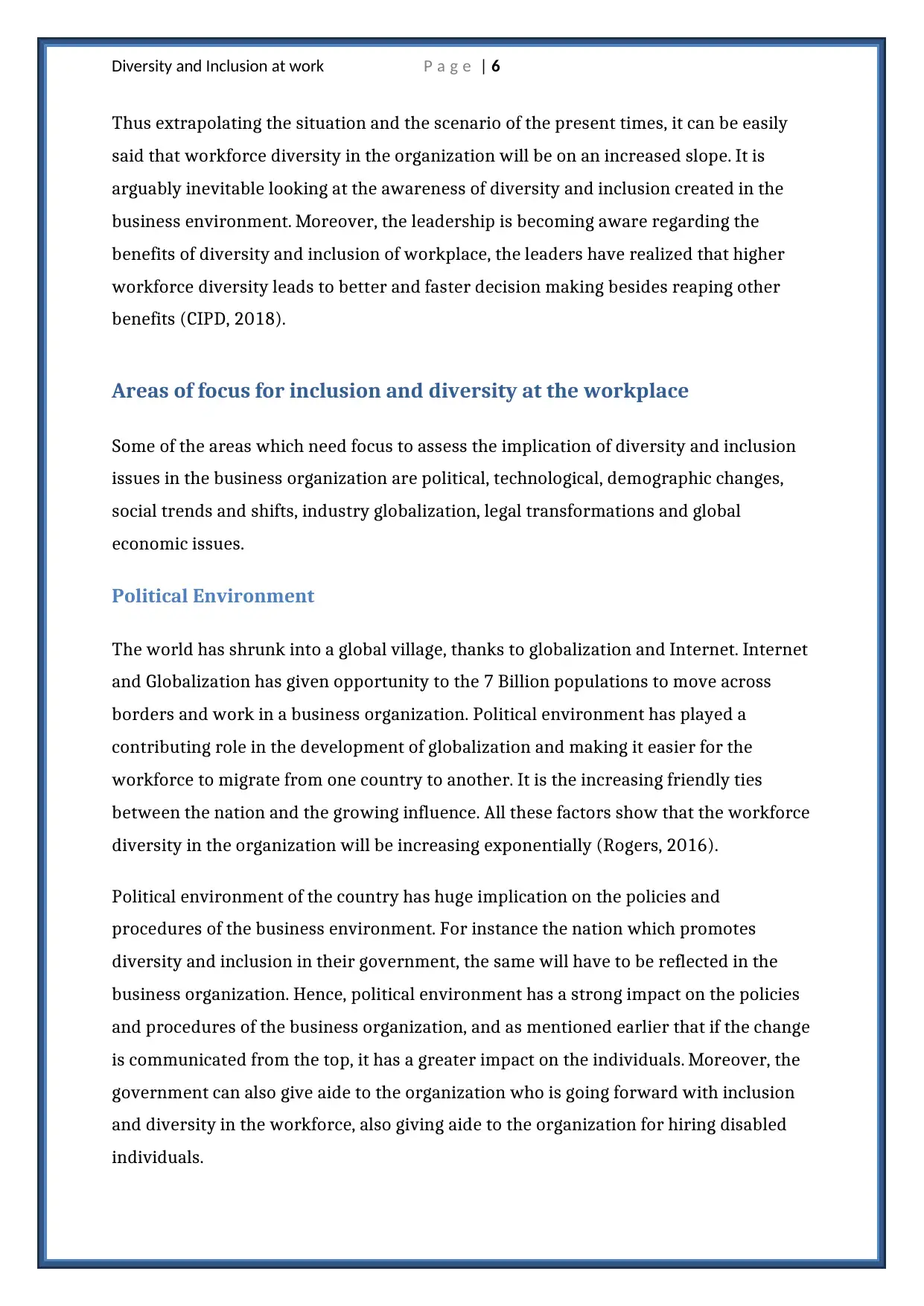
Diversity and Inclusion at work P a g e | 6
Thus extrapolating the situation and the scenario of the present times, it can be easily
said that workforce diversity in the organization will be on an increased slope. It is
arguably inevitable looking at the awareness of diversity and inclusion created in the
business environment. Moreover, the leadership is becoming aware regarding the
benefits of diversity and inclusion of workplace, the leaders have realized that higher
workforce diversity leads to better and faster decision making besides reaping other
benefits (CIPD, 2018).
Areas of focus for inclusion and diversity at the workplace
Some of the areas which need focus to assess the implication of diversity and inclusion
issues in the business organization are political, technological, demographic changes,
social trends and shifts, industry globalization, legal transformations and global
economic issues.
Political Environment
The world has shrunk into a global village, thanks to globalization and Internet. Internet
and Globalization has given opportunity to the 7 Billion populations to move across
borders and work in a business organization. Political environment has played a
contributing role in the development of globalization and making it easier for the
workforce to migrate from one country to another. It is the increasing friendly ties
between the nation and the growing influence. All these factors show that the workforce
diversity in the organization will be increasing exponentially (Rogers, 2016).
Political environment of the country has huge implication on the policies and
procedures of the business environment. For instance the nation which promotes
diversity and inclusion in their government, the same will have to be reflected in the
business organization. Hence, political environment has a strong impact on the policies
and procedures of the business organization, and as mentioned earlier that if the change
is communicated from the top, it has a greater impact on the individuals. Moreover, the
government can also give aide to the organization who is going forward with inclusion
and diversity in the workforce, also giving aide to the organization for hiring disabled
individuals.
Thus extrapolating the situation and the scenario of the present times, it can be easily
said that workforce diversity in the organization will be on an increased slope. It is
arguably inevitable looking at the awareness of diversity and inclusion created in the
business environment. Moreover, the leadership is becoming aware regarding the
benefits of diversity and inclusion of workplace, the leaders have realized that higher
workforce diversity leads to better and faster decision making besides reaping other
benefits (CIPD, 2018).
Areas of focus for inclusion and diversity at the workplace
Some of the areas which need focus to assess the implication of diversity and inclusion
issues in the business organization are political, technological, demographic changes,
social trends and shifts, industry globalization, legal transformations and global
economic issues.
Political Environment
The world has shrunk into a global village, thanks to globalization and Internet. Internet
and Globalization has given opportunity to the 7 Billion populations to move across
borders and work in a business organization. Political environment has played a
contributing role in the development of globalization and making it easier for the
workforce to migrate from one country to another. It is the increasing friendly ties
between the nation and the growing influence. All these factors show that the workforce
diversity in the organization will be increasing exponentially (Rogers, 2016).
Political environment of the country has huge implication on the policies and
procedures of the business environment. For instance the nation which promotes
diversity and inclusion in their government, the same will have to be reflected in the
business organization. Hence, political environment has a strong impact on the policies
and procedures of the business organization, and as mentioned earlier that if the change
is communicated from the top, it has a greater impact on the individuals. Moreover, the
government can also give aide to the organization who is going forward with inclusion
and diversity in the workforce, also giving aide to the organization for hiring disabled
individuals.
Paraphrase This Document
Need a fresh take? Get an instant paraphrase of this document with our AI Paraphraser
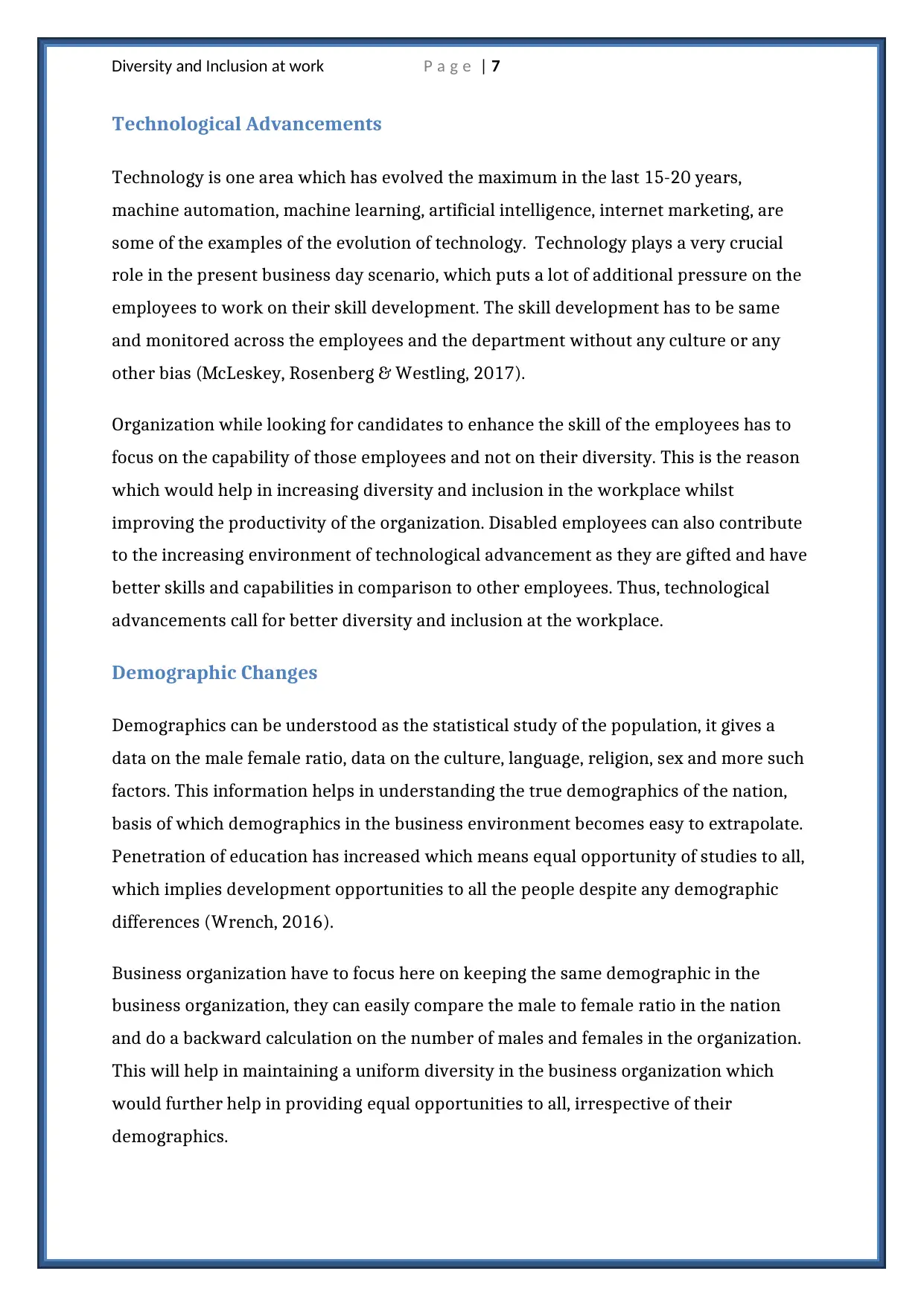
Diversity and Inclusion at work P a g e | 7
Technological Advancements
Technology is one area which has evolved the maximum in the last 15-20 years,
machine automation, machine learning, artificial intelligence, internet marketing, are
some of the examples of the evolution of technology. Technology plays a very crucial
role in the present business day scenario, which puts a lot of additional pressure on the
employees to work on their skill development. The skill development has to be same
and monitored across the employees and the department without any culture or any
other bias (McLeskey, Rosenberg & Westling, 2017).
Organization while looking for candidates to enhance the skill of the employees has to
focus on the capability of those employees and not on their diversity. This is the reason
which would help in increasing diversity and inclusion in the workplace whilst
improving the productivity of the organization. Disabled employees can also contribute
to the increasing environment of technological advancement as they are gifted and have
better skills and capabilities in comparison to other employees. Thus, technological
advancements call for better diversity and inclusion at the workplace.
Demographic Changes
Demographics can be understood as the statistical study of the population, it gives a
data on the male female ratio, data on the culture, language, religion, sex and more such
factors. This information helps in understanding the true demographics of the nation,
basis of which demographics in the business environment becomes easy to extrapolate.
Penetration of education has increased which means equal opportunity of studies to all,
which implies development opportunities to all the people despite any demographic
differences (Wrench, 2016).
Business organization have to focus here on keeping the same demographic in the
business organization, they can easily compare the male to female ratio in the nation
and do a backward calculation on the number of males and females in the organization.
This will help in maintaining a uniform diversity in the business organization which
would further help in providing equal opportunities to all, irrespective of their
demographics.
Technological Advancements
Technology is one area which has evolved the maximum in the last 15-20 years,
machine automation, machine learning, artificial intelligence, internet marketing, are
some of the examples of the evolution of technology. Technology plays a very crucial
role in the present business day scenario, which puts a lot of additional pressure on the
employees to work on their skill development. The skill development has to be same
and monitored across the employees and the department without any culture or any
other bias (McLeskey, Rosenberg & Westling, 2017).
Organization while looking for candidates to enhance the skill of the employees has to
focus on the capability of those employees and not on their diversity. This is the reason
which would help in increasing diversity and inclusion in the workplace whilst
improving the productivity of the organization. Disabled employees can also contribute
to the increasing environment of technological advancement as they are gifted and have
better skills and capabilities in comparison to other employees. Thus, technological
advancements call for better diversity and inclusion at the workplace.
Demographic Changes
Demographics can be understood as the statistical study of the population, it gives a
data on the male female ratio, data on the culture, language, religion, sex and more such
factors. This information helps in understanding the true demographics of the nation,
basis of which demographics in the business environment becomes easy to extrapolate.
Penetration of education has increased which means equal opportunity of studies to all,
which implies development opportunities to all the people despite any demographic
differences (Wrench, 2016).
Business organization have to focus here on keeping the same demographic in the
business organization, they can easily compare the male to female ratio in the nation
and do a backward calculation on the number of males and females in the organization.
This will help in maintaining a uniform diversity in the business organization which
would further help in providing equal opportunities to all, irrespective of their
demographics.
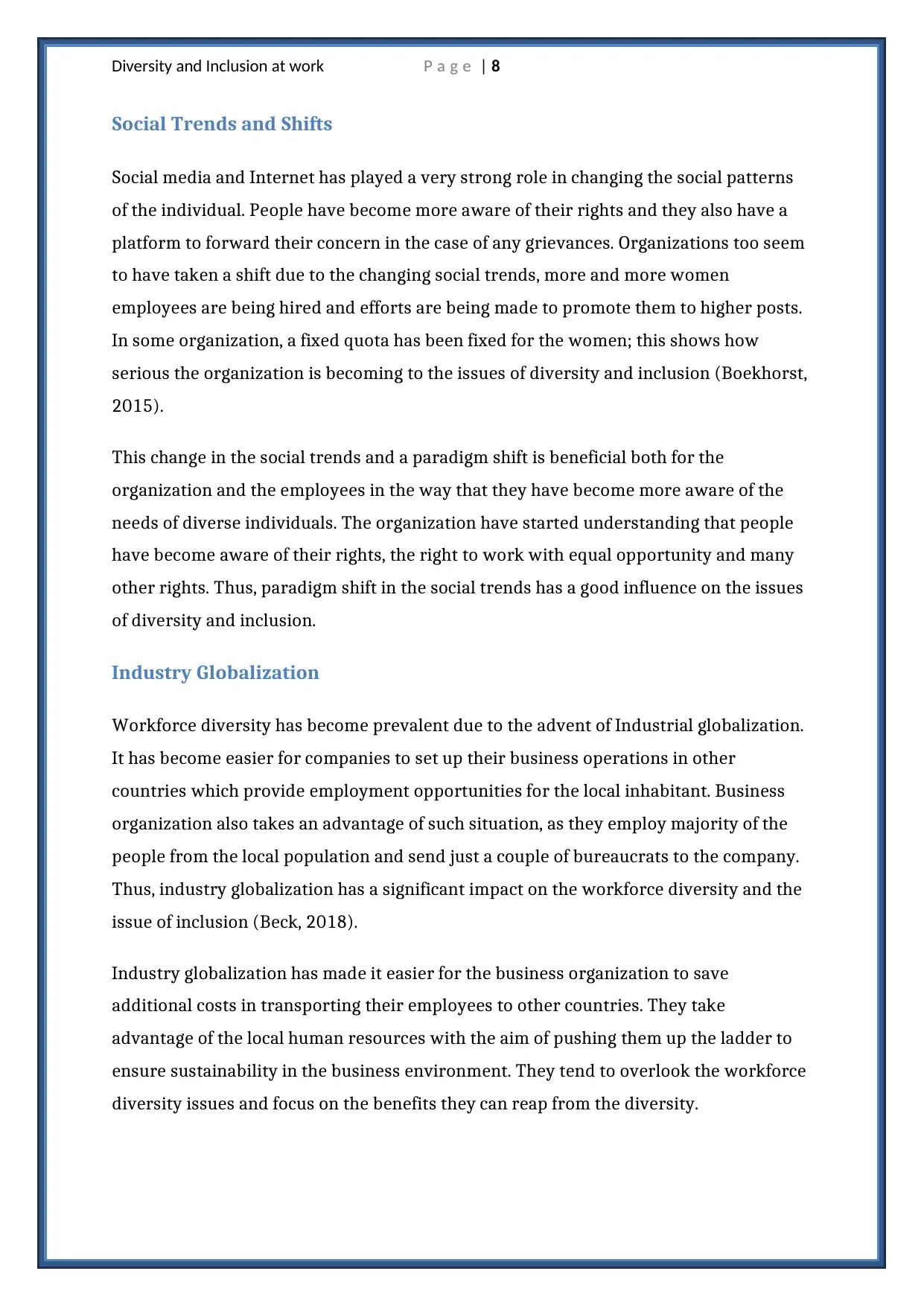
Diversity and Inclusion at work P a g e | 8
Social Trends and Shifts
Social media and Internet has played a very strong role in changing the social patterns
of the individual. People have become more aware of their rights and they also have a
platform to forward their concern in the case of any grievances. Organizations too seem
to have taken a shift due to the changing social trends, more and more women
employees are being hired and efforts are being made to promote them to higher posts.
In some organization, a fixed quota has been fixed for the women; this shows how
serious the organization is becoming to the issues of diversity and inclusion (Boekhorst,
2015).
This change in the social trends and a paradigm shift is beneficial both for the
organization and the employees in the way that they have become more aware of the
needs of diverse individuals. The organization have started understanding that people
have become aware of their rights, the right to work with equal opportunity and many
other rights. Thus, paradigm shift in the social trends has a good influence on the issues
of diversity and inclusion.
Industry Globalization
Workforce diversity has become prevalent due to the advent of Industrial globalization.
It has become easier for companies to set up their business operations in other
countries which provide employment opportunities for the local inhabitant. Business
organization also takes an advantage of such situation, as they employ majority of the
people from the local population and send just a couple of bureaucrats to the company.
Thus, industry globalization has a significant impact on the workforce diversity and the
issue of inclusion (Beck, 2018).
Industry globalization has made it easier for the business organization to save
additional costs in transporting their employees to other countries. They take
advantage of the local human resources with the aim of pushing them up the ladder to
ensure sustainability in the business environment. They tend to overlook the workforce
diversity issues and focus on the benefits they can reap from the diversity.
Social Trends and Shifts
Social media and Internet has played a very strong role in changing the social patterns
of the individual. People have become more aware of their rights and they also have a
platform to forward their concern in the case of any grievances. Organizations too seem
to have taken a shift due to the changing social trends, more and more women
employees are being hired and efforts are being made to promote them to higher posts.
In some organization, a fixed quota has been fixed for the women; this shows how
serious the organization is becoming to the issues of diversity and inclusion (Boekhorst,
2015).
This change in the social trends and a paradigm shift is beneficial both for the
organization and the employees in the way that they have become more aware of the
needs of diverse individuals. The organization have started understanding that people
have become aware of their rights, the right to work with equal opportunity and many
other rights. Thus, paradigm shift in the social trends has a good influence on the issues
of diversity and inclusion.
Industry Globalization
Workforce diversity has become prevalent due to the advent of Industrial globalization.
It has become easier for companies to set up their business operations in other
countries which provide employment opportunities for the local inhabitant. Business
organization also takes an advantage of such situation, as they employ majority of the
people from the local population and send just a couple of bureaucrats to the company.
Thus, industry globalization has a significant impact on the workforce diversity and the
issue of inclusion (Beck, 2018).
Industry globalization has made it easier for the business organization to save
additional costs in transporting their employees to other countries. They take
advantage of the local human resources with the aim of pushing them up the ladder to
ensure sustainability in the business environment. They tend to overlook the workforce
diversity issues and focus on the benefits they can reap from the diversity.
⊘ This is a preview!⊘
Do you want full access?
Subscribe today to unlock all pages.

Trusted by 1+ million students worldwide
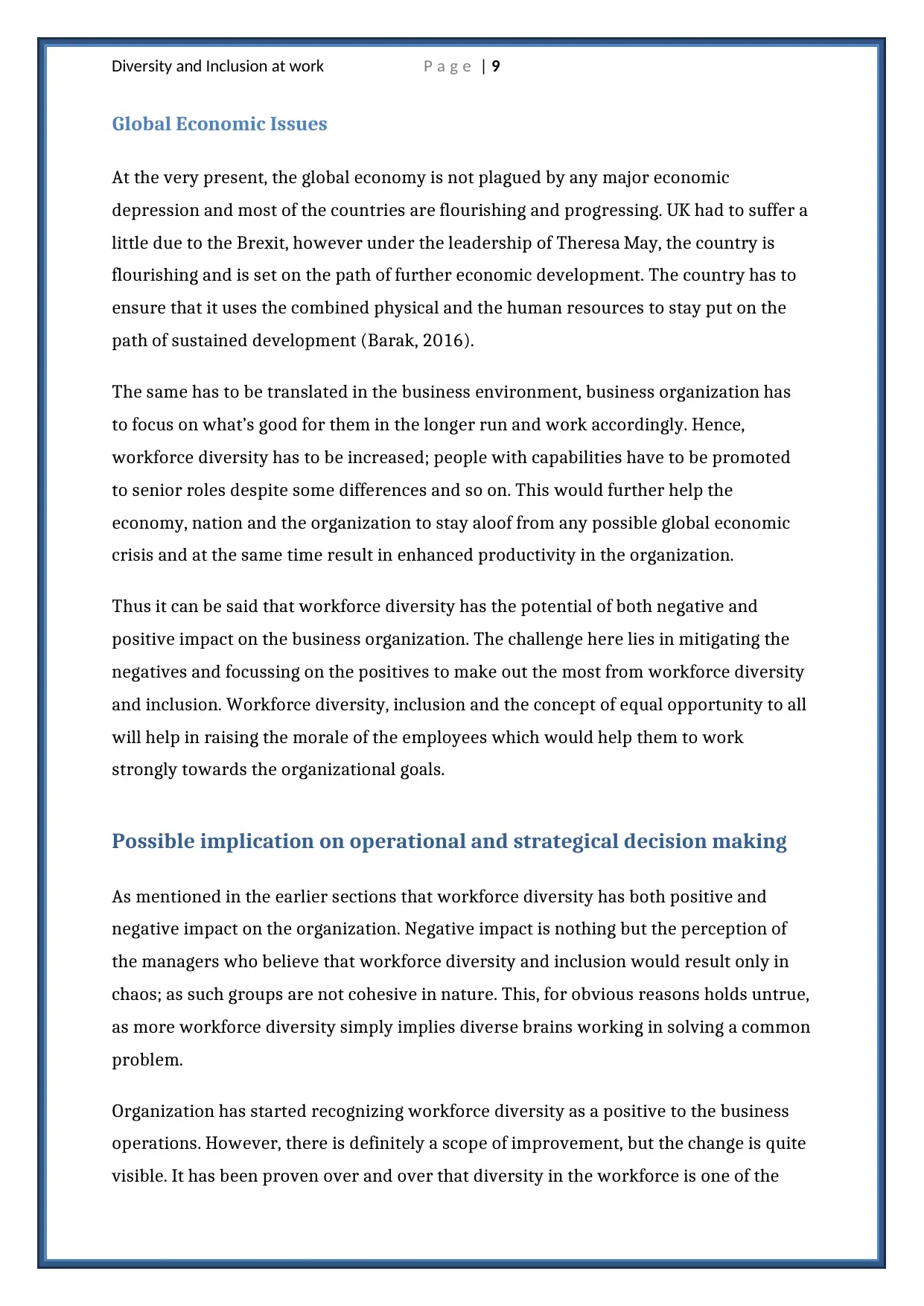
Diversity and Inclusion at work P a g e | 9
Global Economic Issues
At the very present, the global economy is not plagued by any major economic
depression and most of the countries are flourishing and progressing. UK had to suffer a
little due to the Brexit, however under the leadership of Theresa May, the country is
flourishing and is set on the path of further economic development. The country has to
ensure that it uses the combined physical and the human resources to stay put on the
path of sustained development (Barak, 2016).
The same has to be translated in the business environment, business organization has
to focus on what’s good for them in the longer run and work accordingly. Hence,
workforce diversity has to be increased; people with capabilities have to be promoted
to senior roles despite some differences and so on. This would further help the
economy, nation and the organization to stay aloof from any possible global economic
crisis and at the same time result in enhanced productivity in the organization.
Thus it can be said that workforce diversity has the potential of both negative and
positive impact on the business organization. The challenge here lies in mitigating the
negatives and focussing on the positives to make out the most from workforce diversity
and inclusion. Workforce diversity, inclusion and the concept of equal opportunity to all
will help in raising the morale of the employees which would help them to work
strongly towards the organizational goals.
Possible implication on operational and strategical decision making
As mentioned in the earlier sections that workforce diversity has both positive and
negative impact on the organization. Negative impact is nothing but the perception of
the managers who believe that workforce diversity and inclusion would result only in
chaos; as such groups are not cohesive in nature. This, for obvious reasons holds untrue,
as more workforce diversity simply implies diverse brains working in solving a common
problem.
Organization has started recognizing workforce diversity as a positive to the business
operations. However, there is definitely a scope of improvement, but the change is quite
visible. It has been proven over and over that diversity in the workforce is one of the
Global Economic Issues
At the very present, the global economy is not plagued by any major economic
depression and most of the countries are flourishing and progressing. UK had to suffer a
little due to the Brexit, however under the leadership of Theresa May, the country is
flourishing and is set on the path of further economic development. The country has to
ensure that it uses the combined physical and the human resources to stay put on the
path of sustained development (Barak, 2016).
The same has to be translated in the business environment, business organization has
to focus on what’s good for them in the longer run and work accordingly. Hence,
workforce diversity has to be increased; people with capabilities have to be promoted
to senior roles despite some differences and so on. This would further help the
economy, nation and the organization to stay aloof from any possible global economic
crisis and at the same time result in enhanced productivity in the organization.
Thus it can be said that workforce diversity has the potential of both negative and
positive impact on the business organization. The challenge here lies in mitigating the
negatives and focussing on the positives to make out the most from workforce diversity
and inclusion. Workforce diversity, inclusion and the concept of equal opportunity to all
will help in raising the morale of the employees which would help them to work
strongly towards the organizational goals.
Possible implication on operational and strategical decision making
As mentioned in the earlier sections that workforce diversity has both positive and
negative impact on the organization. Negative impact is nothing but the perception of
the managers who believe that workforce diversity and inclusion would result only in
chaos; as such groups are not cohesive in nature. This, for obvious reasons holds untrue,
as more workforce diversity simply implies diverse brains working in solving a common
problem.
Organization has started recognizing workforce diversity as a positive to the business
operations. However, there is definitely a scope of improvement, but the change is quite
visible. It has been proven over and over that diversity in the workforce is one of the
Paraphrase This Document
Need a fresh take? Get an instant paraphrase of this document with our AI Paraphraser
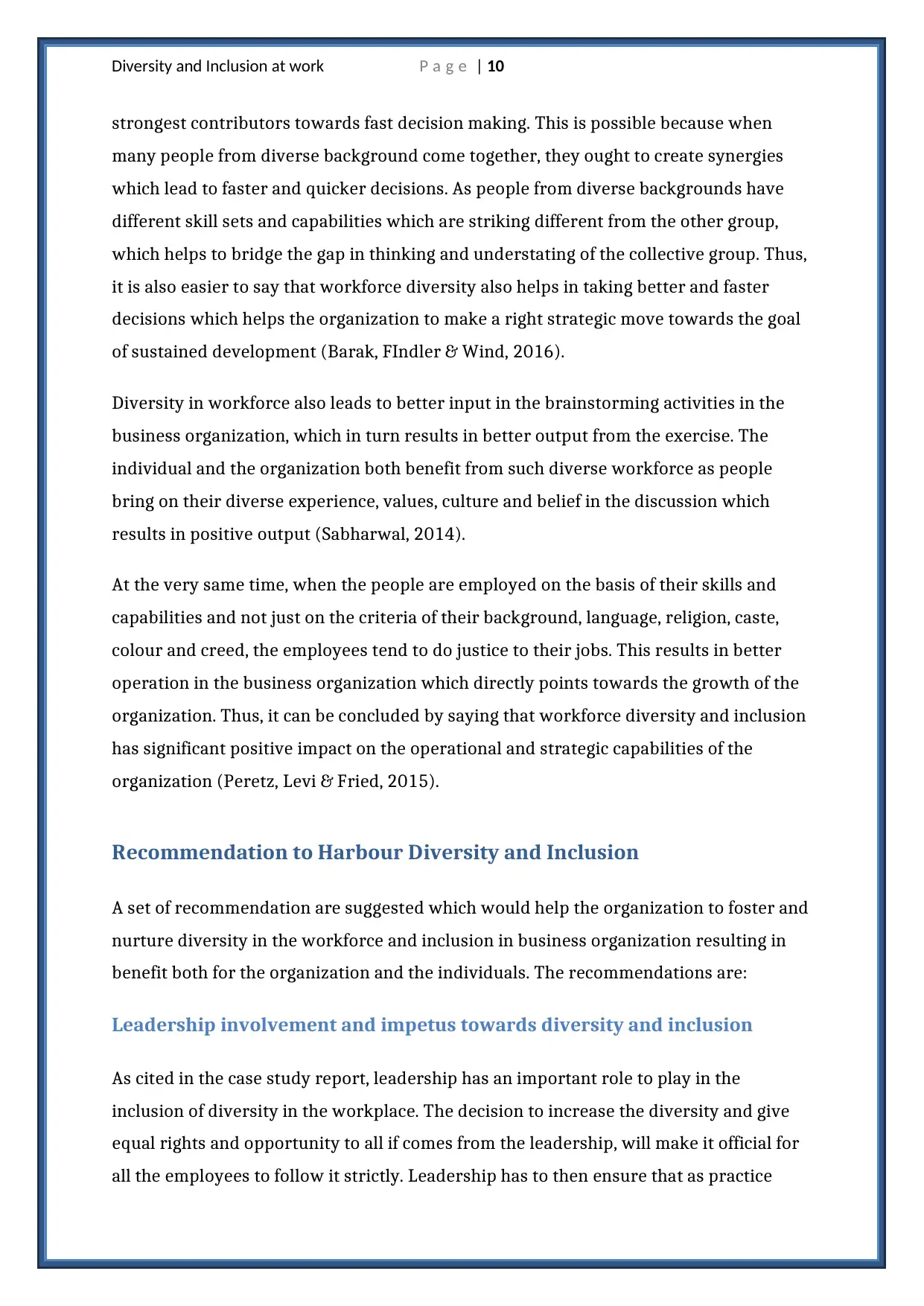
Diversity and Inclusion at work P a g e | 10
strongest contributors towards fast decision making. This is possible because when
many people from diverse background come together, they ought to create synergies
which lead to faster and quicker decisions. As people from diverse backgrounds have
different skill sets and capabilities which are striking different from the other group,
which helps to bridge the gap in thinking and understating of the collective group. Thus,
it is also easier to say that workforce diversity also helps in taking better and faster
decisions which helps the organization to make a right strategic move towards the goal
of sustained development (Barak, FIndler & Wind, 2016).
Diversity in workforce also leads to better input in the brainstorming activities in the
business organization, which in turn results in better output from the exercise. The
individual and the organization both benefit from such diverse workforce as people
bring on their diverse experience, values, culture and belief in the discussion which
results in positive output (Sabharwal, 2014).
At the very same time, when the people are employed on the basis of their skills and
capabilities and not just on the criteria of their background, language, religion, caste,
colour and creed, the employees tend to do justice to their jobs. This results in better
operation in the business organization which directly points towards the growth of the
organization. Thus, it can be concluded by saying that workforce diversity and inclusion
has significant positive impact on the operational and strategic capabilities of the
organization (Peretz, Levi & Fried, 2015).
Recommendation to Harbour Diversity and Inclusion
A set of recommendation are suggested which would help the organization to foster and
nurture diversity in the workforce and inclusion in business organization resulting in
benefit both for the organization and the individuals. The recommendations are:
Leadership involvement and impetus towards diversity and inclusion
As cited in the case study report, leadership has an important role to play in the
inclusion of diversity in the workplace. The decision to increase the diversity and give
equal rights and opportunity to all if comes from the leadership, will make it official for
all the employees to follow it strictly. Leadership has to then ensure that as practice
strongest contributors towards fast decision making. This is possible because when
many people from diverse background come together, they ought to create synergies
which lead to faster and quicker decisions. As people from diverse backgrounds have
different skill sets and capabilities which are striking different from the other group,
which helps to bridge the gap in thinking and understating of the collective group. Thus,
it is also easier to say that workforce diversity also helps in taking better and faster
decisions which helps the organization to make a right strategic move towards the goal
of sustained development (Barak, FIndler & Wind, 2016).
Diversity in workforce also leads to better input in the brainstorming activities in the
business organization, which in turn results in better output from the exercise. The
individual and the organization both benefit from such diverse workforce as people
bring on their diverse experience, values, culture and belief in the discussion which
results in positive output (Sabharwal, 2014).
At the very same time, when the people are employed on the basis of their skills and
capabilities and not just on the criteria of their background, language, religion, caste,
colour and creed, the employees tend to do justice to their jobs. This results in better
operation in the business organization which directly points towards the growth of the
organization. Thus, it can be concluded by saying that workforce diversity and inclusion
has significant positive impact on the operational and strategic capabilities of the
organization (Peretz, Levi & Fried, 2015).
Recommendation to Harbour Diversity and Inclusion
A set of recommendation are suggested which would help the organization to foster and
nurture diversity in the workforce and inclusion in business organization resulting in
benefit both for the organization and the individuals. The recommendations are:
Leadership involvement and impetus towards diversity and inclusion
As cited in the case study report, leadership has an important role to play in the
inclusion of diversity in the workplace. The decision to increase the diversity and give
equal rights and opportunity to all if comes from the leadership, will make it official for
all the employees to follow it strictly. Leadership has to then ensure that as practice
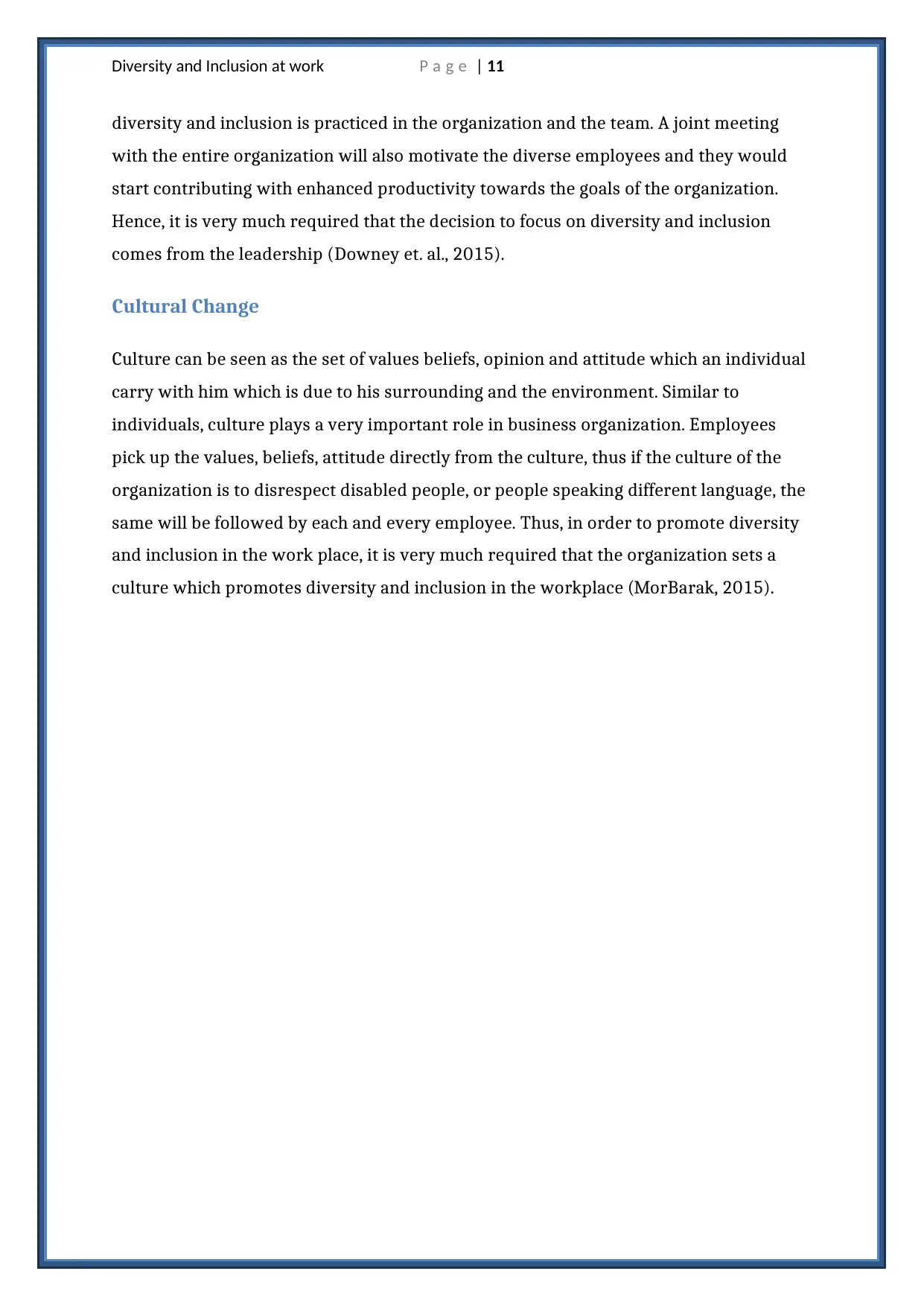
Diversity and Inclusion at work P a g e | 11
diversity and inclusion is practiced in the organization and the team. A joint meeting
with the entire organization will also motivate the diverse employees and they would
start contributing with enhanced productivity towards the goals of the organization.
Hence, it is very much required that the decision to focus on diversity and inclusion
comes from the leadership (Downey et. al., 2015).
Cultural Change
Culture can be seen as the set of values beliefs, opinion and attitude which an individual
carry with him which is due to his surrounding and the environment. Similar to
individuals, culture plays a very important role in business organization. Employees
pick up the values, beliefs, attitude directly from the culture, thus if the culture of the
organization is to disrespect disabled people, or people speaking different language, the
same will be followed by each and every employee. Thus, in order to promote diversity
and inclusion in the work place, it is very much required that the organization sets a
culture which promotes diversity and inclusion in the workplace (MorBarak, 2015).
diversity and inclusion is practiced in the organization and the team. A joint meeting
with the entire organization will also motivate the diverse employees and they would
start contributing with enhanced productivity towards the goals of the organization.
Hence, it is very much required that the decision to focus on diversity and inclusion
comes from the leadership (Downey et. al., 2015).
Cultural Change
Culture can be seen as the set of values beliefs, opinion and attitude which an individual
carry with him which is due to his surrounding and the environment. Similar to
individuals, culture plays a very important role in business organization. Employees
pick up the values, beliefs, attitude directly from the culture, thus if the culture of the
organization is to disrespect disabled people, or people speaking different language, the
same will be followed by each and every employee. Thus, in order to promote diversity
and inclusion in the work place, it is very much required that the organization sets a
culture which promotes diversity and inclusion in the workplace (MorBarak, 2015).
⊘ This is a preview!⊘
Do you want full access?
Subscribe today to unlock all pages.

Trusted by 1+ million students worldwide
1 out of 15
Related Documents
Your All-in-One AI-Powered Toolkit for Academic Success.
+13062052269
info@desklib.com
Available 24*7 on WhatsApp / Email
![[object Object]](/_next/static/media/star-bottom.7253800d.svg)
Unlock your academic potential
Copyright © 2020–2025 A2Z Services. All Rights Reserved. Developed and managed by ZUCOL.





